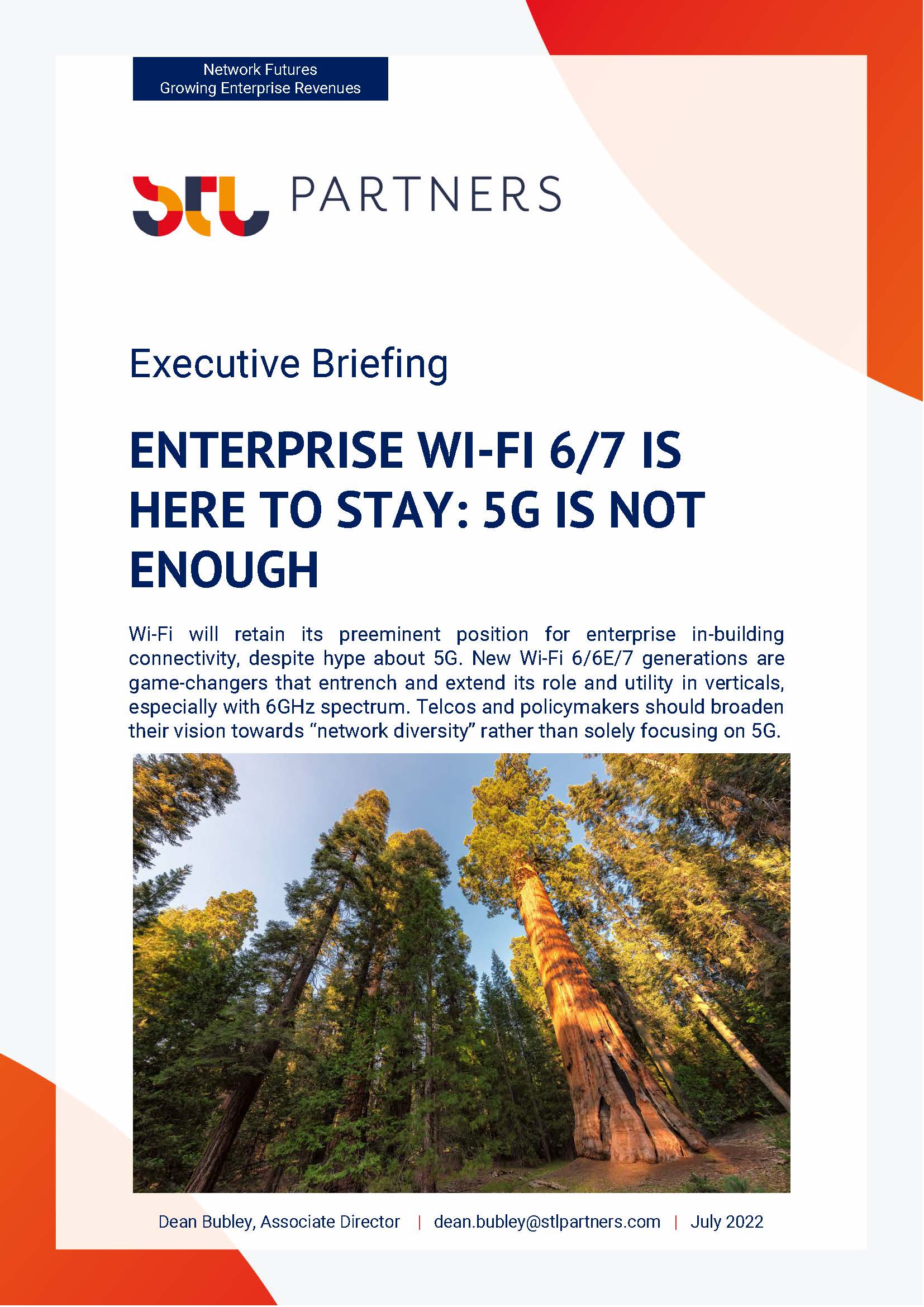Enterprise Wi-Fi 6/7 is here to stay: 5G is not enough
£3,000.00 excl VAT
Wi-Fi will retain its preeminent position for enterprise in-building connectivity, despite hype about 5G. New Wi-Fi 6/6E/7 generations are game-changers that entrench and extend its role and utility in verticals, especially with 6GHz spectrum. Telcos and policymakers should broaden their vision towards “network diversity” rather than solely focusing on 5G.
Description
Format: PDF filePages: 53 pagesCharts: 24Author: Dean BubleyPublication Date: July 2022
Table of Contents
- Executive Summary
- Introduction
- Structure and objectives of this report
- Background and history
- Roles and channels for enterprise Wi-Fi
- Recent enterprise Wi-Fi market trends
- Note on terminology
- The evolution of “Wi-Fi for verticals”
- Understanding Wi-Fi “verticals”
- Existing vertical-specific Wi-Fi solutions
- Wi-Fi in industry verticals – building ecosystems
- Wi-Fi 6, 6E & 7: Rapid cadence or confusion?
- Continual evolution of Wi-Fi capabilities: 6, 6E, 7
- Wi-Fi 7 may be a game-changer for enterprise
- The long-term future: Wi-Fi 8 and beyond
- Other Wi-Fi variants: 60GHz and HaLow
- Where do Wi-Fi and 5G overlap competitively?
- Does private 5G change the game?
- Convergence / divergence
- The political and regulatory dimensions of enterprise wireless
- 6GHz spectrum
- CSPs and enterprise Wi-Fi
- CSPs and large enterprise / industrial Wi-Fi
- Wi-Fi service value-adds
- Wi-Fi and edge compute
- Conclusions
Table of Figures
- Figure 1: Enterprise Wi-Fi solutions cover a broad range of contexts and uses
- Figure 2: Impact of pandemic on enterprise Wi-Fi market volumes and value
- Figure 3: For Wi-Fi, the term “vertical” can have various meanings
- Figure 4: Examples of vertical-focused Wi-Fi or WLAN vendor solutions
- Figure 5: Three approaches for vertical industry ecosystem building for Wi-Fi
- Figure 6: From Wi-Fi 4 to Wi-Fi 7
- Figure 7: Enterprise WiFi is rapidly switching to 6/6E/7 generations
- Figure 8: A busy timeline for Wi-Fi – 2021-25
- Figure 9: Wi-Fi 7 technical features and capabilities
- Figure 10: Wi-Fi is rapidly focusing on latency (low and deterministic)
- Figure 11: Semiconductor players currently leading the push to Wi-Fi 7
- Figure 12: Beyond Wi-Fi 7
- Figure 13: 60GHz Wi-Fi for enterprise indoor and outdoor mesh / backhaul
- Figure 14: Some overlap between 5G and Wi-Fi, but no major replacement either way
- Figure 15: Future roles of public/private 5G, Wi-Fi and other networks
- Figure 16: Comparing technology characteristics for enterprise/industrial networking
- Figure 17: Convergence or divergence for enterprise Wi-Fi and cellular?
- Figure 18: Increasing lobbying for Wi-Fi (and satellite connectivity)
- Figure 19: 6GHz spectrum situation, mid-2022
- Figure 20: Comcast’s view of SME Wi-Fi services opportunities
- Figure 21: CSPs with dedicated enterprise units should be multi-network capable
- Figure 22: Wi-Fi is a core component of WFH/hybrid work solutions for CSPs
- Figure 23: Is Wi-Fi the unexpected driver for edge computing?
- Figure 24: Wi-Fi APs are starting to embed or integrate edge computing resources
Companies: Cisco, Comcast, HPE, Juniper
Keywords: 5G, 6GHz, CBRS, computing, Convergence, CSPs, ecosystems, enterprise, industrial networks, industry verticals, IoT, network diversity, Networking, policy, private cellular, private networks, security, spectrum, Telecoms, Wi-Fi 6, Wi-Fi 6E, Wi-Fi 7


